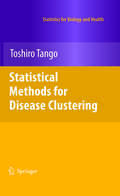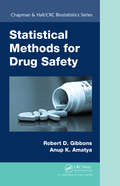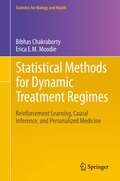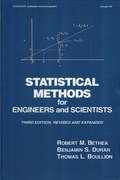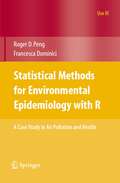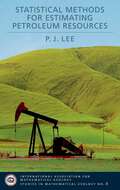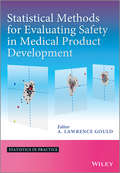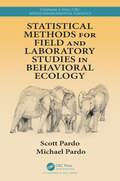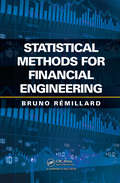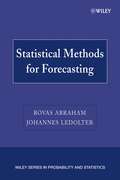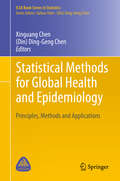- Table View
- List View
Statistical Methods for Data Analysis in Particle Physics (Lecture Notes in Physics #909)
by Luca ListaThis concise set of course-based notes provides the reader with the main concepts and tools to perform statistical analysis of experimental data, in particular in the field of high-energy physics (HEP). First, an introduction to probability theory and basic statistics is given, mainly as reminder from advanced undergraduate studies, yet also in view to clearly distinguish the Frequentist versus Bayesian approaches and interpretations in subsequent applications. More advanced concepts and applications are gradually introduced, culminating in the chapter on upper limits as many applications in HEP concern hypothesis testing, where often the main goal is to provide better and better limits so as to be able to distinguish eventually between competing hypotheses or to rule out some of them altogether. Many worked examples will help newcomers to the field and graduate students to understand the pitfalls in applying theoretical concepts to actual data.
Statistical Methods for Disease Clustering (Statistics for Biology and Health)
by Toshiro TangoThis book is intended to provide a text on statistical methods for detecting clus ters and/or clustering of health events that is of interest to ?nal year undergraduate and graduate level statistics, biostatistics, epidemiology, and geography students but will also be of relevance to public health practitioners, statisticians, biostatisticians, epidemiologists, medical geographers, human geographers, environmental scien tists, and ecologists. Prerequisites are introductory biostatistics and epidemiology courses. With increasing public health concerns about environmental risks, the need for sophisticated methods for analyzing spatial health events is immediate. Further more, the research area of statistical tests for disease clustering now attracts a wide audience due to the perceived need to implement wide ranging monitoring systems to detect possible health related bioterrorism activity. With this background and the development of the geographical information system (GIS), the analysis of disease clustering of health events has seen considerable development over the last decade. Therefore, several excellent books on spatial epidemiology and statistics have re cently been published. However, it seems to me that there is no other book solely focusing on statistical methods for disease clustering. I hope that readers will ?nd this book useful and interesting as an introduction to the subject.
Statistical Methods for Drug Safety
by Robert D. Gibbons Anup AmatyaExplore Important Tools for High-Quality Work in Pharmaceutical SafetyStatistical Methods for Drug Safety presents a wide variety of statistical approaches for analyzing pharmacoepidemiologic data. It covers both commonly used techniques, such as proportional reporting ratios for the analysis of spontaneous adverse event reports, and newer approach
Statistical Methods for Dynamic Disease Screening and Spatio-Temporal Disease Surveillance (Chapman & Hall/CRC Biostatistics Series)
by Peihua QiuDisease screening and disease surveillance (DSDS) constitute two critical areas in public health, each presenting distinctive challenges primarily due to their sequential decision-making nature and complex data structures. Statistical Methods for Dynamic Disease Screening and Spatio-Temporal Disease Surveillance explores numerous recent analytic methodologies that enhance traditional techniques. The author, a prominent researcher specializing in innovative sequential decision-making techniques, demonstrates how these novel methods effectively address the challenges of DSDS.After a concise introduction that lays the groundwork for comprehending the challenges inherent in DSDS, the book delves into fundamental statistical concepts and methods relevant to DSDS. This includes exploration of statistical process control (SPC) charts specifically crafted for sequential decision-making purposes. The subsequent chapters systematically outline recent advancements in dynamic screening system (DySS) methods, fine-tuned for effective disease screening. Additionally, the text covers both traditional and contemporary analytic methods for disease surveillance. It further introduces two recently developed R packages designed for implementing DySS methods and spatio-temporal disease surveillance techniques pioneered by the author's research team.Features• Presents Recent Analytic Methods for DSDS: The book introduces analytic methods for DSDS based on SPC charts. These methods effectively utilize all historical data, accommodating the complex data structure inherent in sequential decision-making processes.• Introduces Recent R Packages: Two recent R packages, DySS and SpTe2M, are introduced. The book not only presents these packages but also demonstrates key DSDS methods using them.• Examines Recent Research Results: The text delves into the latest research findings across various domains, including dynamic disease screening, nonparametric spatio-temporal data modeling and monitoring, and spatio-temporal disease surveillance.• Accessible Description of Methods: Major methods are described in a manner accessible to individuals without advanced knowledge in mathematics and statistics. The goal is to facilitate a clear understanding of ideas and easy implementation.• Real-Data Examples: To aid comprehension, the book provides several real-data examples illustrating key concepts and methods.• Hands-on Exercises: Each chapter includes exercises to encourage hands-on practice, allowing readers to engage directly with the presented methods.
Statistical Methods for Dynamic Disease Screening and Spatio-Temporal Disease Surveillance (Chapman & Hall/CRC Biostatistics Series)
by Peihua QiuDisease screening and disease surveillance (DSDS) constitute two critical areas in public health, each presenting distinctive challenges primarily due to their sequential decision-making nature and complex data structures. Statistical Methods for Dynamic Disease Screening and Spatio-Temporal Disease Surveillance explores numerous recent analytic methodologies that enhance traditional techniques. The author, a prominent researcher specializing in innovative sequential decision-making techniques, demonstrates how these novel methods effectively address the challenges of DSDS.After a concise introduction that lays the groundwork for comprehending the challenges inherent in DSDS, the book delves into fundamental statistical concepts and methods relevant to DSDS. This includes exploration of statistical process control (SPC) charts specifically crafted for sequential decision-making purposes. The subsequent chapters systematically outline recent advancements in dynamic screening system (DySS) methods, fine-tuned for effective disease screening. Additionally, the text covers both traditional and contemporary analytic methods for disease surveillance. It further introduces two recently developed R packages designed for implementing DySS methods and spatio-temporal disease surveillance techniques pioneered by the author's research team.Features• Presents Recent Analytic Methods for DSDS: The book introduces analytic methods for DSDS based on SPC charts. These methods effectively utilize all historical data, accommodating the complex data structure inherent in sequential decision-making processes.• Introduces Recent R Packages: Two recent R packages, DySS and SpTe2M, are introduced. The book not only presents these packages but also demonstrates key DSDS methods using them.• Examines Recent Research Results: The text delves into the latest research findings across various domains, including dynamic disease screening, nonparametric spatio-temporal data modeling and monitoring, and spatio-temporal disease surveillance.• Accessible Description of Methods: Major methods are described in a manner accessible to individuals without advanced knowledge in mathematics and statistics. The goal is to facilitate a clear understanding of ideas and easy implementation.• Real-Data Examples: To aid comprehension, the book provides several real-data examples illustrating key concepts and methods.• Hands-on Exercises: Each chapter includes exercises to encourage hands-on practice, allowing readers to engage directly with the presented methods.
Statistical Methods for Dynamic Treatment Regimes: Reinforcement Learning, Causal Inference, and Personalized Medicine (Statistics for Biology and Health #76)
by Bibhas Chakraborty Erica E.M. MoodieStatistical Methods for Dynamic Treatment Regimes shares state of the art of statistical methods developed to address questions of estimation and inference for dynamic treatment regimes, a branch of personalized medicine. This volume demonstrates these methods with their conceptual underpinnings and illustration through analysis of real and simulated data. These methods are immediately applicable to the practice of personalized medicine, which is a medical paradigm that emphasizes the systematic use of individual patient information to optimize patient health care. This is the first single source to provide an overview of methodology and results gathered from journals, proceedings, and technical reports with the goal of orienting researchers to the field. The first chapter establishes context for the statistical reader in the landscape of personalized medicine. Readers need only have familiarity with elementary calculus, linear algebra, and basic large-sample theory to use this text. Throughout the text, authors direct readers to available code or packages in different statistical languages to facilitate implementation. In cases where code does not already exist, the authors provide analytic approaches in sufficient detail that any researcher with knowledge of statistical programming could implement the methods from scratch. This will be an important volume for a wide range of researchers, including statisticians, epidemiologists, medical researchers, and machine learning researchers interested in medical applications. Advanced graduate students in statistics and biostatistics will also find material in Statistical Methods for Dynamic Treatment Regimes to be a critical part of their studies.
Statistical Methods for Engineers and Scientists, Third Edition,
by Robert M. BetheaThis work details the fundamentals of applied statistics and experimental design, presenting a unified approach to data handling that emphasizes the analysis of variance, regression analysis and the use of Statistical Analysis System computer programs. This edition: discusses modern nonparametric methods; contains information on statistical process control and reliability; supplies fault and event trees; furnishes numerous additional end-of-chapter problems and worked examples; and more.
Statistical Methods for Engineers and Scientists, Third Edition,
by Robert M. BetheaThis work details the fundamentals of applied statistics and experimental design, presenting a unified approach to data handling that emphasizes the analysis of variance, regression analysis and the use of Statistical Analysis System computer programs. This edition: discusses modern nonparametric methods; contains information on statistical process control and reliability; supplies fault and event trees; furnishes numerous additional end-of-chapter problems and worked examples; and more.
Statistical Methods for Environmental and Agricultural Sciences
by Reza HoshmandThe first edition of this book, popular around the world, is surpassed only by this new Second Edition. Improvements such as new and revised exercises, a broad range of practical and relevant case studies, and expanded theoretical concepts make this even better for users of statistics. The book emphasizes the practical application of statistics and provides examples in various fields of environmental and agriculture sciences. Because it uses simple, non-mathematical language to present statistical techniques, the reader requires only a familiarity with elementary algebra and mathematical notations to understand and apply the concepts described. This logically organized book covers the following topics: Part 1 introduces statistical concepts as they apply to different fields of environmental and agriculture sciences and provides descriptive measures of central tendency and variability; Part 2 covers probability and sampling concepts used in inferential statistics; Part 3 presents parametric methods in hypothesis testing, which include research designs; Part 4 discusses a number of nonparametric techniques; Part 5 explains tests of association and prediction; and lastly, analysis of change over time is detailed in Part 6. The appendices contain statistical tables for reference purposes.
Statistical Methods for Environmental and Agricultural Sciences
by Reza HoshmandThe first edition of this book, popular around the world, is surpassed only by this new Second Edition. Improvements such as new and revised exercises, a broad range of practical and relevant case studies, and expanded theoretical concepts make this even better for users of statistics. The book emphasizes the practical application of statistics and provides examples in various fields of environmental and agriculture sciences. Because it uses simple, non-mathematical language to present statistical techniques, the reader requires only a familiarity with elementary algebra and mathematical notations to understand and apply the concepts described. This logically organized book covers the following topics: Part 1 introduces statistical concepts as they apply to different fields of environmental and agriculture sciences and provides descriptive measures of central tendency and variability; Part 2 covers probability and sampling concepts used in inferential statistics; Part 3 presents parametric methods in hypothesis testing, which include research designs; Part 4 discusses a number of nonparametric techniques; Part 5 explains tests of association and prediction; and lastly, analysis of change over time is detailed in Part 6. The appendices contain statistical tables for reference purposes.
Statistical Methods for Environmental Epidemiology with R: A Case Study in Air Pollution and Health (Use R!)
by Roger D. Peng Francesca DominiciAs an area of statistical application, environmental epidemiology and more speci cally, the estimation of health risk associated with the exposure to - vironmental agents, has led to the development of several statistical methods and software that can then be applied to other scienti c areas. The stat- tical analyses aimed at addressing questions in environmental epidemiology have the following characteristics. Often the signal-to-noise ratio in the data is low and the targets of inference are inherently small risks. These constraints typically lead to the development and use of more sophisticated (and pot- tially less transparent) statistical models and the integration of large hi- dimensional databases. New technologies and the widespread availability of powerful computing are also adding to the complexities of scienti c inves- gation by allowing researchers to t large numbers of models and search over many sets of variables. As the number of variables measured increases, so do the degrees of freedom for in uencing the association between a risk factor and an outcome of interest. We have written this book, in part, to describe our experiences developing and applying statistical methods for the estimation for air pollution health e ects. Our experience has convinced us that the application of modern s- tistical methodology in a reproducible manner can bring to bear subst- tial bene ts to policy-makers and scientists in this area. We believe that the methods described in this book are applicable to other areas of environmental epidemiology, particularly those areas involving spatial{temporal exposures.
Statistical Methods for Estimating Petroleum Resources (International Association for Mathematical Geology Studies in Mathematical Geology)
by P.J. LeeThis book describes procedures for determining the total hydrocarbon (petroleum) resource or resource potential in a region. Statistical concepts and methods employed in petroleum resource assessment are the subject of the manuscript, extensively illustrated by numerous real case studies. Prof. Lee's computer-aided Petroleum Information Management and Resource Evaluation System (PETRIMES) methodology has been adopted by governments around the world and by major multinational oil companies to perform resource assessment and to predict future oil and gas production. Though this methodology is so widely used, there is no "user's guide" to it, and this book will be the definitive resource for PETRIMES users.
Statistical Methods for Evaluating Safety in Medical Product Development (Statistics in Practice)
by A. Lawrence GouldThis book gives professionals in clinical research valuable information on the challenging issues of the design, execution, and management of clinical trials, and how to resolve these issues effectively. It also provides understanding and practical guidance on the application of contemporary statistical methods to contemporary issues in safety evaluation during medical product development. Each chapter provides sufficient detail to the reader to undertake the design and analysis of experiments at various stages of product development, including comprehensive references to the relevant literature. Provides a guide to statistical methods and application in medical product development Assists readers in undertaking design and analysis of experiments at various stages of product development Features case studies throughout the book, as well as, SAS and R code
Statistical Methods for Evaluating Safety in Medical Product Development (Statistics in Practice)
by A. Lawrence GouldThis book gives professionals in clinical research valuable information on the challenging issues of the design, execution, and management of clinical trials, and how to resolve these issues effectively. It also provides understanding and practical guidance on the application of contemporary statistical methods to contemporary issues in safety evaluation during medical product development. Each chapter provides sufficient detail to the reader to undertake the design and analysis of experiments at various stages of product development, including comprehensive references to the relevant literature. Provides a guide to statistical methods and application in medical product development Assists readers in undertaking design and analysis of experiments at various stages of product development Features case studies throughout the book, as well as, SAS and R code
Statistical Methods for Experimental Research in Education and Psychology (Springer Texts in Education)
by Jimmie LeppinkThis book focuses on experimental research in two disciplines that have a lot of common ground in terms of theory, experimental designs used, and methods for the analysis of experimental research data: education and psychology. Although the methods covered in this book are also frequently used in many other disciplines, including sociology and medicine, the examples in this book come from contemporary research topics in education and psychology. Various statistical packages, commercial and zero-cost Open Source ones, are used.The goal of this book is neither to cover all possible statistical methods out there nor to focus on a particular statistical software package. There are many excellent statistics textbooks on the market that present both basic and advanced concepts at an introductory level and/or provide a very detailed overview of options in a particular statistical software programme. This is not yet another book in that genre. Core theme of this book is a heuristic called the question-design-analysis bridge: there is a bridge connecting research questions and hypotheses, experimental design and sampling procedures, and common statistical methods in that context. Each statistical method is discussed in a concrete context of a set of research question with directed (one-sided) or undirected (two-sided) hypotheses and an experimental setup in line with these questions and hypotheses. Therefore, the titles of the chapters in this book do not include any names of statistical methods such as ‘analysis of variance’ or ‘analysis of covariance’. In a total of seventeen chapters, this book covers a wide range of topics of research questions that call for experimental designs and statistical methods, fairly basic or more advanced.
Statistical Methods for Field and Laboratory Studies in Behavioral Ecology (Chapman & Hall/CRC Applied Environmental Statistics)
by Scott Pardo Michael PardoStatistical Methods for Field and Laboratory Studies in Behavioral Ecology focuses on how statistical methods may be used to make sense of behavioral ecology and other data. It presents fundamental concepts in statistical inference and intermediate topics such as multiple least squares regression and ANOVA. The objective is to teach students to recognize situations where various statistical methods should be used, understand the strengths and limitations of the methods, and to show how they are implemented in R code. Examples are based on research described in the literature of behavioral ecology, with data sets and analysis code provided. Features: This intermediate to advanced statistical methods text was written with the behavioral ecologist in mind Computer programs are provided, written in the R language. Datasets are also provided, mostly based, at least to some degree, on real studies. Methods and ideas discussed include multiple regression and ANOVA, logistic and Poisson regression, machine learning and model identification, time-to-event modeling, time series and stochastic modeling, game-theoretic modeling, multivariate methods, study design/sample size, and what to do when things go wrong. It is assumed that the reader has already had exposure to statistics through a first introductory course at least, and also has sufficient knowledge of R. However, some introductory material is included to aid the less initiated reader. Scott Pardo, Ph.D., is an accredited professional statistician (PStat®) by the American Statistical Association. Michael Pardo is a Ph.D. is a candidate in behavioral ecology at Cornell University, specializing in animal communication and social behavior.
Statistical Methods for Field and Laboratory Studies in Behavioral Ecology (Chapman & Hall/CRC Applied Environmental Statistics)
by Scott Pardo Michael PardoStatistical Methods for Field and Laboratory Studies in Behavioral Ecology focuses on how statistical methods may be used to make sense of behavioral ecology and other data. It presents fundamental concepts in statistical inference and intermediate topics such as multiple least squares regression and ANOVA. The objective is to teach students to recognize situations where various statistical methods should be used, understand the strengths and limitations of the methods, and to show how they are implemented in R code. Examples are based on research described in the literature of behavioral ecology, with data sets and analysis code provided. Features: This intermediate to advanced statistical methods text was written with the behavioral ecologist in mind Computer programs are provided, written in the R language. Datasets are also provided, mostly based, at least to some degree, on real studies. Methods and ideas discussed include multiple regression and ANOVA, logistic and Poisson regression, machine learning and model identification, time-to-event modeling, time series and stochastic modeling, game-theoretic modeling, multivariate methods, study design/sample size, and what to do when things go wrong. It is assumed that the reader has already had exposure to statistics through a first introductory course at least, and also has sufficient knowledge of R. However, some introductory material is included to aid the less initiated reader. Scott Pardo, Ph.D., is an accredited professional statistician (PStat®) by the American Statistical Association. Michael Pardo is a Ph.D. is a candidate in behavioral ecology at Cornell University, specializing in animal communication and social behavior.
Statistical Methods for Financial Engineering
by Bruno RemillardWhile many financial engineering books are available, the statistical aspects behind the implementation of stochastic models used in the field are often overlooked or restricted to a few well-known cases. Statistical Methods for Financial Engineering guides current and future practitioners on implementing the most useful stochastic models used in f
Statistical Methods for Food and Agriculture
by Filmore E BenderThis classic book will meet the needs of food and agricultural industries in both their research and business needs. Learn the fundamentals of applying statistics to the business and research needs in the food and agricultural industries. Statistical Methods for Food and Agriculture is a practical, hands-on resource that explores how statistics, a relatively recent development for science and business, facilitates the decision-making process. The range of techniques and applications explained and demonstrated in each of the four major sections of this volume provides a substantial course of study for those in business, government, and universities dealing with food, agriculture, and economics.Part I provides an introduction to the uses of statistics today, including basic concepts and definitions.Part II examines the statistical needs of the food researcher. The emphasis is on design of planned experiments, the analysis of data generated by planned experiments, and decision making in a research environment.Part III deals with statistical procedures that have a wide range of uses for the researcher and business analyst in both business and research situations.Part IV focuses on those statistical methods that have primarily a business application. This important volume is sufficiently detailed to enable the reader to learn and develop without outside assistance. References lead to more detailed presentations for those desiring additional specialized information, and helpful exercises at the end of each chapter permit the book?s use as a textbook as well.
Statistical Methods for Food and Agriculture
by Filmore E BenderThis classic book will meet the needs of food and agricultural industries in both their research and business needs. Learn the fundamentals of applying statistics to the business and research needs in the food and agricultural industries. Statistical Methods for Food and Agriculture is a practical, hands-on resource that explores how statistics, a relatively recent development for science and business, facilitates the decision-making process. The range of techniques and applications explained and demonstrated in each of the four major sections of this volume provides a substantial course of study for those in business, government, and universities dealing with food, agriculture, and economics.Part I provides an introduction to the uses of statistics today, including basic concepts and definitions.Part II examines the statistical needs of the food researcher. The emphasis is on design of planned experiments, the analysis of data generated by planned experiments, and decision making in a research environment.Part III deals with statistical procedures that have a wide range of uses for the researcher and business analyst in both business and research situations.Part IV focuses on those statistical methods that have primarily a business application. This important volume is sufficiently detailed to enable the reader to learn and develop without outside assistance. References lead to more detailed presentations for those desiring additional specialized information, and helpful exercises at the end of each chapter permit the book?s use as a textbook as well.
Statistical Methods for Forecasting (Wiley Series in Probability and Statistics #234)
by Bovas Abraham Johannes LedolterThe Wiley-Interscience Paperback Series consists of selected books that have been made more accessible to consumers in an effort to increase global appeal and general circulation. With these new unabridged softcover volumes, Wiley hopes to extend the lives of these works by making them available to future generations of statisticians, mathematicians, and scientists. "This book, it must be said, lives up to the words on its advertising cover: 'Bridging the gap between introductory, descriptive approaches and highly advanced theoretical treatises, it provides a practical, intermediate level discussion of a variety of forecasting tools, and explains how they relate to one another, both in theory and practice.' It does just that!" -Journal of the Royal Statistical Society "A well-written work that deals with statistical methods and models that can be used to produce short-term forecasts, this book has wide-ranging applications. It could be used in the context of a study of regression, forecasting, and time series analysis by PhD students; or to support a concentration in quantitative methods for MBA students; or as a work in applied statistics for advanced undergraduates." -Choice Statistical Methods for Forecasting is a comprehensive, readable treatment of statistical methods and models used to produce short-term forecasts. The interconnections between the forecasting models and methods are thoroughly explained, and the gap between theory and practice is successfully bridged. Special topics are discussed, such as transfer function modeling; Kalman filtering; state space models; Bayesian forecasting; and methods for forecast evaluation, comparison, and control. The book provides time series, autocorrelation, and partial autocorrelation plots, as well as examples and exercises using real data. Statistical Methods for Forecasting serves as an outstanding textbook for advanced undergraduate and graduate courses in statistics, business, engineering, and the social sciences, as well as a working reference for professionals in business, industry, and government.
Statistical Methods for Fuzzy Data (Wiley Series In Probability And Statistics Ser. #213)
by Reinhard ViertlStatistical data are not always precise numbers, or vectors, or categories. Real data are frequently what is called fuzzy. Examples where this fuzziness is obvious are quality of life data, environmental, biological, medical, sociological and economics data. Also the results of measurements can be best described by using fuzzy numbers and fuzzy vectors respectively. Statistical analysis methods have to be adapted for the analysis of fuzzy data. In this book, the foundations of the description of fuzzy data are explained, including methods on how to obtain the characterizing function of fuzzy measurement results. Furthermore, statistical methods are then generalized to the analysis of fuzzy data and fuzzy a-priori information. Key Features: Provides basic methods for the mathematical description of fuzzy data, as well as statistical methods that can be used to analyze fuzzy data. Describes methods of increasing importance with applications in areas such as environmental statistics and social science. Complements the theory with exercises and solutions and is illustrated throughout with diagrams and examples. Explores areas such quantitative description of data uncertainty and mathematical description of fuzzy data. This work is aimed at statisticians working with fuzzy logic, engineering statisticians, finance researchers, and environmental statisticians. It is written for readers who are familiar with elementary stochastic models and basic statistical methods.
Statistical Methods for Fuzzy Data (Wiley Series in Probability and Statistics)
by Reinhard ViertlStatistical data are not always precise numbers, or vectors, or categories. Real data are frequently what is called fuzzy. Examples where this fuzziness is obvious are quality of life data, environmental, biological, medical, sociological and economics data. Also the results of measurements can be best described by using fuzzy numbers and fuzzy vectors respectively. Statistical analysis methods have to be adapted for the analysis of fuzzy data. In this book, the foundations of the description of fuzzy data are explained, including methods on how to obtain the characterizing function of fuzzy measurement results. Furthermore, statistical methods are then generalized to the analysis of fuzzy data and fuzzy a-priori information. Key Features: Provides basic methods for the mathematical description of fuzzy data, as well as statistical methods that can be used to analyze fuzzy data. Describes methods of increasing importance with applications in areas such as environmental statistics and social science. Complements the theory with exercises and solutions and is illustrated throughout with diagrams and examples. Explores areas such quantitative description of data uncertainty and mathematical description of fuzzy data. This work is aimed at statisticians working with fuzzy logic, engineering statisticians, finance researchers, and environmental statisticians. It is written for readers who are familiar with elementary stochastic models and basic statistical methods.
Statistical Methods for Global Health and Epidemiology: Principles, Methods and Applications (ICSA Book Series in Statistics)
by Xinguang Chen Din Ding-Geng ChenThis book examines statistical methods and models used in the fields of global health and epidemiology. It includes methods such as innovative probability sampling, data harmonization and encryption, and advanced descriptive, analytical and monitory methods. Program codes using R are included as well as real data examples. Contemporary global health and epidemiology involves a myriad of medical and health challenges, including inequality of treatment, the HIV/AIDS epidemic and its subsequent control, the flu, cancer, tobacco control, drug use, and environmental pollution. In addition to its vast scales and telescopic perspective; addressing global health concerns often involves examining resource-limited populations with large geographic, socioeconomic diversities. Therefore, advancing global health requires new epidemiological design, new data, and new methods for sampling, data processing, and statistical analysis. This book provides global health researchers with methods that will enable access to and utilization of existing data. Featuring contributions from both epidemiological and biostatistical scholars, this book is a practical resource for researchers, practitioners, and students in solving global health problems in research, education, training, and consultation.
Statistical Methods for Groundwater Monitoring (Statistics in Practice #59)
by Robert D. Gibbons Dulal K. Bhaumik Subhash AryalA new edition of the most comprehensive overview of statistical methods for environmental monitoring applications Thoroughly updated to provide current research findings, Statistical Methods for Groundwater Monitoring, Second Edition continues to provide a comprehensive overview and accessible treatment of the statistical methods that are useful in the analysis of environmental data. This new edition expands focus on statistical comparison to regulatory standards that are a vital part of assessment, compliance, and corrective action monitoring in the environmental sciences. The book explores quantitative concepts useful for surface water monitoring as well as soil and air monitoring applications while also maintaining a focus on the analysis of groundwater monitoring data in order to detect environmental impacts from a variety of sources, such as industrial activity and waste disposal. The authors introduce the statistical properties of alternative approaches, such as false positive and false negative rates, that are associated with each test and the factors related to these error rates. The Second Edition also features: An introduction to Intra-laboratory Calibration Curves and random-effects regression models for non-constant measurement variability Coverage of statistical prediction limits for a gamma-distributed random variable, with a focus on estimation and testing of parameters in environmental monitoring applications A unified treatment of censored data with the computation of statistical prediction, tolerance, and control limits Expanded coverage of statistical issues related to laboratory practice, such as detection and quantitation limits An updated chapter on regulatory issues that outlines common mistakes to avoid in groundwater monitoring applications as well as an introduction to the newest regulations for both hazardous and municipal solid waste facilities Each chapter provides a general overview of a problem, followed by statistical derivation of the solution and a relevant example complete with computational details that allow readers to perform routine application of the statistical results. Relevant issues are highlighted throughout, and recommendations are also provided for specific problems based on characteristics such as number of monitoring wells, number of constituents, distributional form of measurements, and detection frequency. Statistical Methods for Groundwater Monitoring, Second Edition is an excellent supplement to courses on environmental statistics at the upper-undergraduate and graduate levels. It is also a valuable resource for researchers and practitioners in the fields of biostatistics, engineering, and the environmental sciences who work with statistical methods in their everyday work.

